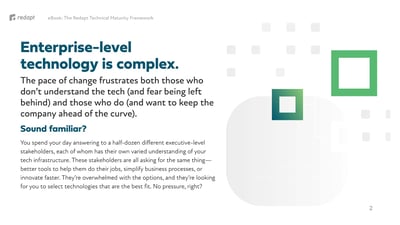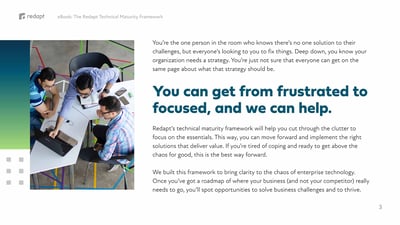As technology continues to advance, traditional business models are falling in its wake.
Take banking. Just a few years ago, interfacing with your banking institution meant working through a phone tree or physically entering a brick and mortar building. Now, nearly all your banking needs can be done via an app on your phone.
Download Now: The Redapt Technical Maturity Framework
This is just one of many examples of why every company these days needs to be a tech company in order to stay competitive. The question is, how do you make the transformation?
Changes from the top

On a strategic level, the roles of the CIO and CTO at Fortune 500 companies have changed drastically in recent years.
IT and technologies used to be just a cost center for major companies. Now those same companies are looking for them to drive new revenue, make the company more competitive, and be a direct channel for communication with customers in new and innovative ways.
Here’s an example:
A major shoe company with an iconic logo wants to better connect with its customers in order to increase brand loyalty.
Instead of traditional outreach means, the company develops a mobile app that helps people with their favorite sports activities, whether it’s running, golf, or basketball.
Not only does this pivot make the company seem more innovative, it develops customer retention. If you’re going to buy a new pair of running shoes, after all, you’re more likely to stick with the one that already has your progress clocked.
How to become a tech company
Making the transition to a tech company takes more than simply declaring you’re one at the next shareholder meeting.
For traditionally non-tech industries in particular, it takes developing a thorough understanding of your current technical capabilities.
That’s where a technical maturity framework comes in.
Based on the maturity models developed for the U.S. Air Force in the 1980s, a technical maturity framework is used to position a company so they can put emerging technologies to work.
The framework helps you:
- Assess your current technology infrastructure
- Identify areas beyond your current capabilities
- Align your tech needs to your business priorities
- Develop a roadmap for your transformation
How does this work in practice? Let’s go back to the major shoe company with an iconic logo.
Before beginning work on a mobile app, the company needed to determine whether it was something their customers would even want. That meant research and examining data.
By applying a technical maturity framework to their business, the company was able to build out the capability to process large amounts of data.
They were also able to determine how much of an investment they needed to make in order to build and support a mobile app by either bringing the talent necessary in-house or hiring a third party.
Getting started with your own framework

If you’re looking to transform your own company, a good first step is to fully wrap your head around just what a technical maturity framework can deliver.
For that, we’ve developed a free eBook called The Redapt Technical Maturity Framework. In it, we walk you through every step of applying the framework to your business, from defining your level of maturity to defining your business priorities.
You can also reach out to us directly for answers to any of your tech needs, framework or otherwise.


















